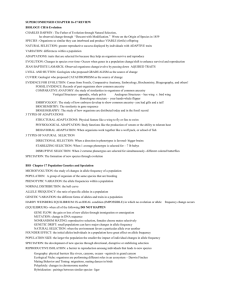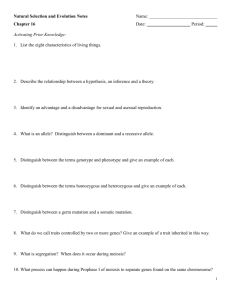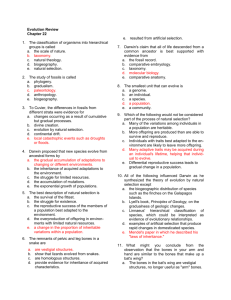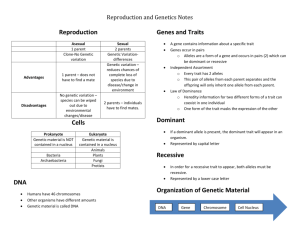CONCEPT 1: Mechanisms for Evolution
advertisement
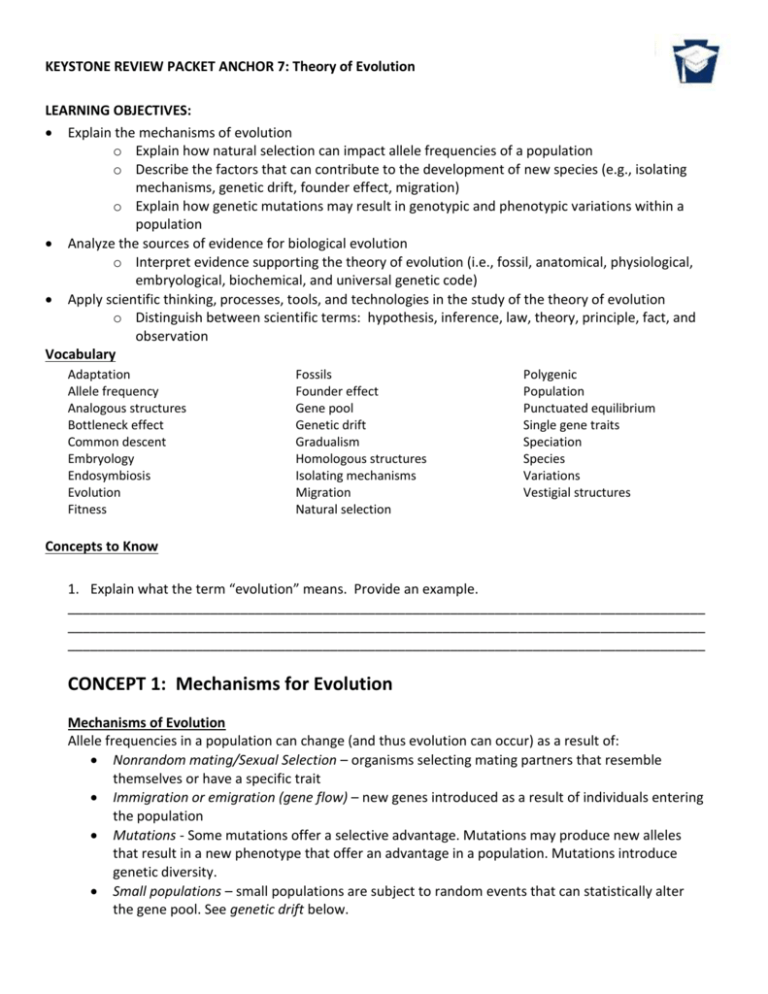
KEYSTONE REVIEW PACKET ANCHOR 7: Theory of Evolution LEARNING OBJECTIVES: Explain the mechanisms of evolution o Explain how natural selection can impact allele frequencies of a population o Describe the factors that can contribute to the development of new species (e.g., isolating mechanisms, genetic drift, founder effect, migration) o Explain how genetic mutations may result in genotypic and phenotypic variations within a population Analyze the sources of evidence for biological evolution o Interpret evidence supporting the theory of evolution (i.e., fossil, anatomical, physiological, embryological, biochemical, and universal genetic code) Apply scientific thinking, processes, tools, and technologies in the study of the theory of evolution o Distinguish between scientific terms: hypothesis, inference, law, theory, principle, fact, and observation Vocabulary Adaptation Allele frequency Analogous structures Bottleneck effect Common descent Embryology Endosymbiosis Evolution Fitness Fossils Founder effect Gene pool Genetic drift Gradualism Homologous structures Isolating mechanisms Migration Natural selection Polygenic Population Punctuated equilibrium Single gene traits Speciation Species Variations Vestigial structures Concepts to Know 1. Explain what the term “evolution” means. Provide an example. _____________________________________________________________________________________ _____________________________________________________________________________________ _____________________________________________________________________________________ CONCEPT 1: Mechanisms for Evolution Mechanisms of Evolution Allele frequencies in a population can change (and thus evolution can occur) as a result of: Nonrandom mating/Sexual Selection – organisms selecting mating partners that resemble themselves or have a specific trait Immigration or emigration (gene flow) – new genes introduced as a result of individuals entering the population Mutations - Some mutations offer a selective advantage. Mutations may produce new alleles that result in a new phenotype that offer an advantage in a population. Mutations introduce genetic diversity. Small populations – small populations are subject to random events that can statistically alter the gene pool. See genetic drift below. Genetic drift – changes in the gene pool caused by random events in a small population o Bottleneck – when an event (e.g., a flood) drastically reduces the size of a population. The allele frequencies of the survivors are not the same as the allele frequencies of the original population. As the population grows, the allele frequencies will represent the frequencies from the bottleneck population, not the original population. o Founder effect – a small number of individual colonize a new habitat. The allele frequencies of the new population will reflect the alleles of the founders, not the original population they came from. Natural selection – survival and reproduction of individuals based on inherited traits. Those organisms with certain phenotypes may be better adapted to their environment and will survive and reproduce. The frequency of the alleles for that phenotype will increase in the population. 2. The combined genetic information of all members of a particular population forms a ____________. 3. The frequency of a particular allele changes from 30% to 10 %. Is this population evolving? _______ 4. What are the 2 types of genetic drift? Briefly describe each type. _____________________________________________________________________________________ _____________________________________________________________________________________ _____________________________________________________________________________________ 5. Does natural selection work directly on genotypes or phenotypes? _________________ Natural Selection Highlighted Charles Darwin concluded that biological evolution occurs as a result of natural selection, which is the theory that in any given generation, some individuals are more likely to survive and reproduce than others. In order for natural selection to occur in a population, several conditions must be met: Individuals in the population must produce more offspring than can survive. Human beings are somewhat unique among living things in that we can make conscious choices about how many offspring we have. Most other organisms, however, produce as many offspring as they can. Those individuals must have different characteristics. During Darwin’s time, no one knew where these differences came from. Now scientists know that differences in organisms arise due to mutations in DNA combined with the mixing of genetic information during sexual reproduction. Offspring must inherit some characteristics from their parents. During Darwin’s time, the laws of inheritance were just beginning to be figured out, so Darwin didn’t know exactly how parents passed on their traits. Modern scientists know that traits are inherited when parents pass genes on to their offspring. Organisms with the best-suited characteristics for their environment are more likely to survive and reproduce. This is the heart of natural selection. If there’s competition for survival and not all the organisms are the same, then the ones with the advantageous traits are more likely to survive. If these traits can be inherited, then the next generation will show more of these advantageous traits. If these four conditions are met, then the new generation of individuals will be different from the original generation in the frequency and distribution of traits, which is pretty much the definition of biological evolution. 6. What is natural selection? _____________________________________________________________________________________ _____________________________________________________________________________________ 7. How does natural selection relate to evolution? _____________________________________________________________________________________ _____________________________________________________________________________________ 8. Describe the conditions necessary for natural selection to occur. _____________________________________________________________________________________ _____________________________________________________________________________________ _____________________________________________________________________________________ 9. What are the sources for genetic variation? _____________________________________________________________________________________ _____________________________________________________________________________________ 10. An inherited characteristic that increases an organism’s ability to survive and reproduce in its environment is called an _______________________. 11. How well an organism survived and reproduces in its environment can be described as its ________. Speciation The formation of a new, genetically distinct species from populations of existing species Occurs when the gene pool for a group of organisms becomes reproductively isolated (which can occur when any of the evolution mechanisms noted above cause populations to become so genetically different that they can no longer mate). Differences, in the genetics of a population that has been isolated, build up over time until they can no longer produce fertile offspring Types of Speciation o Allopatric speciation – Two populations of a species are separated geographically or by a physical barrier. Each population evolves specific adaptations for their environment. Over time the genetic differences become so great that the populations can no longer interbreed and are two separate species. o Sympatric speciation – A species evolves into a new species without a physical barrier. Usually happens as a result of a sudden genetic change. Happens fairly frequently in plants through polyploidy, an increase in the chromosome number. Isolating Mechanisms (reproductive isolation) - features or behaviors, morphology, or genetics which prevent mating or breeding between two different species o Temporal Isolation – individuals are active at different times of the day, seasons, or mating periods o Ecological Isolation – individuals only mate in their specific habitat o Behavorial Isolation – there are no sexual cues between representatives of the species o Mechanical Isolation – when there is no sperm transfer during attempted mating o Gametic Incompatibility – when there is sperm transfer without fertilization occurring Patterns of Evolution o Adaptive radiation – The production of a number of different species from a single ancestral species. o Coevolution – When the evolution of one species affects the evolution of another species (mutualism is an example of coevolution). o Convergent evolution - unrelated species evolve similar traits even though they live in different parts of the world. Occurs in environments that are geographically far apart but that have similar ecology and climate. Rate of Speciation o Gradualism – the theory that evolution proceeds in small, gradual steps, i.e., that new species arise from the result of slight modifications (mutations and resulting phenotypic changes) over many generations. o Punctuated equilibrium – the theory that rapid spurts of genetic change cause species to diverge quickly; these periods punctuate much longer period when the species exhibit little change. Types of Selection (with polygenic traits) Directional Selection – individuals that display a more extreme form of a trait have greater fitness than individuals with an average form of the trait Disruptive Selection – (also called diversifying selection) individuals with either extreme variation of a trait have greater fitness Stabilizing Selection – individuals with the average form of a trait have the highest fitness 12. The formation of new, genetically distinct species from populations of exiting species is called ______________. 13. What are 5 different isolating mechanisms? _____________________________________________________________________________________ _____________________________________________________________________________________ 14. Explain the 2 different theories on the rate of speciation. _____________________________________________________________________________________ _____________________________________________________________________________________ _____________________________________________________________________________________ 15. What are the 3 types of selection that occur when polygenic traits are evolving? Write a brief description of each. _____________________________________________________________________________________ _____________________________________________________________________________________ _____________________________________________________________________________________ CONCEPT 2: Evidence for Evolution Previously, the main evidence for evolution was based on anatomy (structures) or physiology (functions) of organisms. Currently, comparing biochemical evidence (DNA, RNA, or protein sequences) provides scientists with the most detailed information. In general, the more similarities two organisms share, the more recently they diverged from a common ancestor. EMBROLOGY compares the embryos of different species. The similar development patterns of the species above indicates that they shared a common ancestor FOSSIL EVIDENCE links present day organisms to the common ancestors. Here we see the bones of modern horses (top) and how much it has changed from common ancestors (bottom) BIOCHEMICAL EVIDENCE compares the differences in either DNA or proteins (in this case, proteins. The lamprey has the most differences from humans, which indicates we diverged from the lampreys (are less related) much longer ago than the macaques (more related) HOMOLOGOUS STRUCTURES are structures that have the same shape/form, but are used differently. The bones in the center are from the common ancestor, but each species has evolved to use them differently Not shown are vestigial structures, which are structures reduced in size that are no longer needed but were present in a common ancestor (think of the human tail bone or wisdom teeth. In addition, whales have tiny little hip bones but no legs, which suggests that that the ancestor of the whale walked on land and returned to the sea!). Also not shown are analogous structures, which are structures that look the same but are made out of different materials. This shows that species have changed to adapt to the environment in a similar manner. 16. Explain how each of the following provide evidence for evolution. Vestigial sturctures:____________________________________________________________________________ ____________________________________________________________________________________________ ____________________________________________________________________________________________ Homologous sturctures:_________________________________________________________________________ ____________________________________________________________________________________________ ____________________________________________________________________________________________ Fossils:______________________________________________________________________________________ ____________________________________________________________________________________________ ____________________________________________________________________________________________ Embryology:__________________________________________________________________________________ ____________________________________________________________________________________________ ____________________________________________________________________________________________ Molecular biology:_____________________________________________________________________________ ____________________________________________________________________________________________ ____________________________________________________________________________________________ 17. If species A and B have very similar genes and proteins, what is probably true? ____________________________________________________________________________________________ ____________________________________________________________________________________________ CONCEPT 3: Applying Scientific Thinking to Evolution Hypothesis – A proposed, scientifically testable explanation for an observed phenomenon. Inference – An assumption based on prior experience. Law – Generalizes a body of observations. At the time it is made, no exceptions have been found to the law. Serves as the basis for scientific principles. Scientific laws explain things, but they do not describe them. Theory – An explanation of natural phenomenon based on many observations and investigations over time. Principle – A concept based on scientific laws and axioms (rules assumed to be present, true, and valid) where general agreement is present. Fact – indisputable observations Observation – a direct method of gathering information in an orderly way. Scientists make observations. Scientists will then formulate a hypothesis based on inferences in order to explain their observations. Once the hypothesis is tested and confirmed, it becomes a theory. Only when a theory has withstood every challenge and has been proven to provide reproducible results does it become a recognized scientific law. There is no 'proof' or absolute 'truth' in science. The closest we get are facts. Practice Questions 1. The frequency of an allele in a fly population changes from 89% to 20% after three generations. Which other events most likely occurred during the same time period? A. An environmental change and a fly population increase B. An environmental change and a fly population decrease C. Interbreeding of flies with an invasive species and fly population speciation D. Interbreeding of flies with an established local species and fly population speciation 2. Tail length in mice varies within a population. Scientists observed change in the distribution of tail lengths in a mouse population over time. At the genetic level, what has most likely happened to the allele for the shortest tail length? A. B. C. D. The allele changed from being dominant to being recessive. The allele changed from being autosomal to being sex-linked. The allele became less frequent than the alleles for longer tail lengths. The allele to code for long tail lengths instead of the shortest ones. 3. A group of students measured a ten-square-meter section of a pond ecosystem and recorded observations. Which statement is a testable hypothesis? Student’s Observations of a Pond Ecosystem Quantitative Qualitative 37 fish and 3 frogs Leaves lie on the bottom of the pond. 2 types of aquatic grass Water insects move along the water’s surface. 12 small rocks and 1 medium rock All 3 frogs are sitting on a pond bank. sand A. B. C. D. The frogs living in the pond represent a population. Water is an abiotic component in the pond ecosystem. If the fish are given more food, then they will be happier. If the frogs are startled then they will jump into the water. 4. Which is one way that natural selection differs from genetic drift? A. Natural selection causes the frequencies of alleles in a population to change. B. Natural selection affects smaller populations more often than larger populations. C. Natural selection results from some individuals producing more offspring than others. D. Natural selection depends on some traits helping individuals survive in their environment. 5. A particular gene has two alleles, G and g. Each allele has a frequency of 50% in a population. Which is most likely to preserve these allele frequencies? A. The population doubles in size over several generations. B. A number of individuals with one allele migrate from the population. C. One allele results in a phenotype that better enables organisms to reproduce. D. A population bottleneck temporarily reduces the population size by one-tenth. 6. Recently, bears have been found in the Arctic Circle that are hybrids between grizzly bears and polar bears. Which type of isolating mechanism keeps these species from producing offspring? A. Mating and breeding in different habitats B. Production of a nonviable embryo or fetus C. Inability of sperm to reach the egg during mating D. Failure of the fertilized egg to implant in the uterus 7. Under which of the following conditions would a dominant allele that coded for a fatal disease most likely remain in a population? A. The allele is acted on by natural selection. B. The gene is expressed only in members of one sex. C. The gene is expressed in individuals late in their lives. D. The allele mutates to a nonfatal form during an individual’s lifetime. 8. The graphs illustrate change in a lizard population over time. Which process most likely led to the change in the lizard population? A. B. C. D. natural selection acting on a harmful trait natural selection acting on a beneficial trait natural selection acting on a dominant trait natural selection acting on a recessive trait 9. In North America, the eastern spotted skunk mates in late winter, and the western spotted skunk mates in late summer. Even though their geographic ranges overlap, the species do not mate with each other. What most likely prevents these two species from interbreeding? A. habitat isolation B. geographic isolation C. gametic isolation D. reproductive isolation 10. A mutation occurs in the genes that code for coat color in deer. Which change will most likely result from this mutation? A. a change in the selection pressures acting on coat color B. a change in the coat-color genes of deer predator species C. an increase in coat-color diversity in the population D. an increase in the number of genes for coat color in the population 11. The skeletons of mammalian forelimbs represent variations of a structure that was present in their common ancestor. What has most likely caused the variation in forelimbs? A. B. C. D. changes in muscle structure trait formation due to behaviors changes in the genetic codes development of vestigial structures



